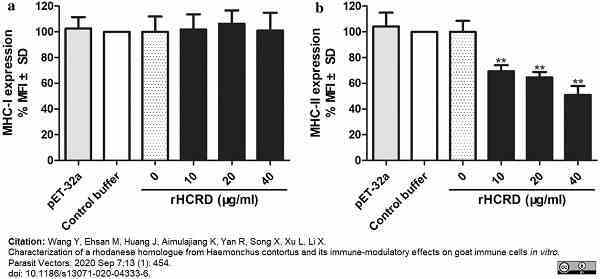MHC Class I antibody | 2G5




Mouse anti Mouse MHC Class I
- Product Type
- Monoclonal Antibody
- Clone
- 2G5
- Isotype
- IgG2b
- Specificity
- MHC Class I
| Mouse anti Mouse MHC Class I antibody, clone 2G5 recognizes a monomorphic epitope present on murine MHC class I molecules, expressed at varying levels on the majority of nucleated cells. The major histocompatibility complex (MHC) is a cluster of genes that are important in the immune response to infections. In mice, this complex is referred to as the histocompatibility 2 (H-2) region. The epitope recognized by clone 2G5 is conformation dependent and is reported to be phylogenetically conserved (Claesson et al. 1994). Reactivity has been observed with some canine samples suggesting that this antibody may recognize a polymorphic epitope of canine MHC class I. |
- Target Species
- Mouse
- Species Cross-Reactivity
-
Target Species Cross Reactivity Rat Guinea Pig Sheep Bovine Pig Human Hamster - N.B. Antibody reactivity and working conditions may vary between species.
- Product Form
- Purified IgG - liquid
- Preparation
- Purified IgG prepared by affinity chromatography on Protein A from tissue culture supernatant
- Buffer Solution
- Phosphate buffered saline
- Preservative Stabilisers
- 0.09% sodium azide (NaN3)
- Carrier Free
- Yes
- Immunogen
- Purified H-2Kb and H-2Db MHC-I molecules.
- Approx. Protein Concentrations
- IgG concentration 1.0 mg/ml
- Fusion Partners
- Spleen cells from immunized C1D mice were fused with cells of the X63 myeloma cell line.
- Regulatory
- For research purposes only
- Guarantee
- 12 months from date of despatch
Avoid repeated freezing and thawing as this may denature the antibody. Storage in frost-free freezers is not recommended.
| Application Name | Verified | Min Dilution | Max Dilution |
|---|---|---|---|
| Flow Cytometry | 1/10 | 1/25 | |
| Immunoprecipitation |
- Flow Cytometry
- Use 10μl of the suggested working dilution to label 106 cells in 100μl
Source Reference
-
Claesson, M.H. et al. (1994) Antibodies directed against monomorphic and evolutionary conserved self epitopes may be generated in 'knock-out' mice. Development of monoclonal antibodies directed against monomorphic MHC class I determinants.
Scand J Immunol. 40 (2): 257-64.
References for MHC Class I antibody
-
Cenci, E. et al. (2006) Modulation of phenotype and function of dendritic cells by a therapeutic synthetic killer peptide.
J Leukoc Biol. 79 (1): 40-5. -
Perone, M.J. et al. (2006) Dendritic cells expressing transgenic galectin-1 delay onset of autoimmune diabetes in mice.
J Immunol. 177 (8): 5278-89. -
Giunchetti, R.C. et al. (2007) Immunogenicity of a killed Leishmania vaccine with saponin adjuvant in dogs.
Vaccine. 25 (44): 7674-86. -
Huang, Y.C. et al. (2008) CD5-low expression lymphocytes in canine peripheral blood show characteristics of natural killer cells.
J Leukoc Biol. 84 (6): 1501-10. -
Liu, C.C. et al. (2008) Transient downregulation of monocyte-derived dendritic-cell differentiation, function, and survival during tumoral progression and regression in an in vivo canine model of transmissible venereal tumor.
Cancer Immunol Immunother. 57 (4): 479-91. -
Letellier, M. et al. (2008) Normal adult climbing fiber monoinnervation of cerebellar Purkinje cells in mice lacking MHC class I molecules.
Dev Neurobiol. 68 (8): 997-1006. -
Giunchetti RC et al. (2008) A killed Leishmania vaccine with sand fly saliva extract and saponin adjuvant displays immunogenicity in dogs.
Vaccine. 26 (5): 623-38. -
Vitadello, M. et al. (2010) Myofiber stress-response in myositis: parallel investigations on patients and experimental animal models of muscle regeneration and systemic inflammation.
Arthritis Res Ther. 12 (2): R52.
View The Latest Product References
-
Gupta, A. et al. (2012) Efficacy of Mycobacterium indicus pranii immunotherapy as an adjunct to chemotherapy for tuberculosis and underlying immune responses in the lung.
PLoS One. 7 (7): e39215. -
Patel, G.K. et al. (2012) A humanized stromal bed is required for engraftment of isolated human primary squamous cell carcinoma cells in immunocompromised mice.
J Invest Dermatol. 132 (2): 284-90. -
Gupta, A. et al. (2012) Protective efficacy of Mycobacterium indicus pranii against tuberculosis and underlying local lung immune responses in guinea pig model.
Vaccine. 30 (43): 6198-209. -
Zuza, A.L. et al. (2016) Astrocyte response to St. Louis encephalitis virus.
Virus Res. 217: 92-100. -
Reid E et al. (2016) Type I and III IFNs Produced by Plasmacytoid Dendritic Cells in Response to a Member of the Flaviviridae Suppress Cellular Immune Responses.
J Immunol. 196 (10): 4214-26. -
Iwasaki, Y. et al. (2016) Differentiation/Purification Protocol for Retinal Pigment Epithelium from Mouse Induced Pluripotent Stem Cells as a Research Tool.
PLoS One. 11 (7): e0158282. -
Wang, Y. et al. (2020) Characterization of a rhodanese homologue from Haemonchus contortus and its immune-modulatory effects on goat immune cells in vitro.
Parasit Vectors. 13 (1): 454. -
Ehsan, M. et al. (2021) Fasciola gigantica tegumental calcium-binding EF-hand protein 4 exerts immunomodulatory effects on goat monocytes.
Parasit Vectors. 14 (1): 276.
Further Reading
-
Piriou-Guzylack, L. (2008) Membrane markers of the immune cells in swine: an update.
Vet Res. 39: 54.
- RRID
- AB_324082
MCA2189
If you cannot find the batch/lot you are looking for please contact our technical support team for assistance.
Please Note: All Products are "FOR RESEARCH PURPOSES ONLY"
View all Anti-Mouse ProductsAlways be the first to know.
When we launch new products and resources to help you achieve more in the lab.
Yes, sign me up


